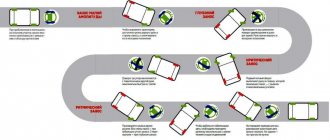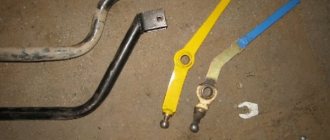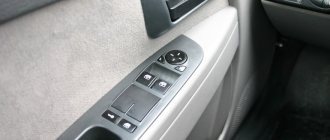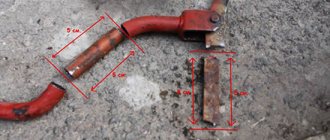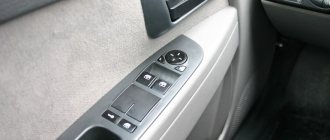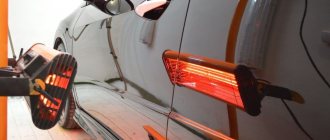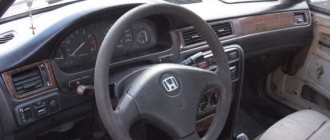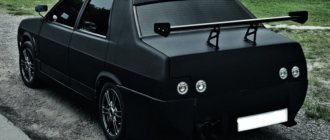It’s hard to say why, but many people think about purchasing Oka. In society, it is believed that this car is a wonderful gift for a wife or mother-in-law. But not everyone will like such simple transport, even though ladies need something compact during their trips to the grocery store, the gym or the pool. Those people who do not have money now will not buy a foreign car - the same Ford Ka or something similar. After all, it will take time to accumulate the necessary amount. If you need a car now, this is not the solution.
"Oka." and why is this needed?
In a word, choosing this car is a big compromise. To ensure that the purchase does not bring disappointment, you need to take care of the details: find out what, how, and how much such a car will cost. Many people recommend seeking advice from an experienced friend who has impressive experience in “cooperation” with the domestic auto industry and can guide anyone through the riffs of such an event as buying a first car. This will eliminate the biased influence of the seller and prevent abuse of the incompetence of the future owner of the vehicle. The following will be done:
• all details about the car, possible accidents, mileage, etc. have been clarified. • after talking with friends who owned this miniature vehicle, “childhood diseases” and vulnerabilities were identified; • it was clarified where the new Oka was produced - at KAMAZ or SEAZ.
How much does a car cost for the people?
The last car rolled off the assembly line back in 2008, with the exception of a small-scale batch that was released in 2010. The car was designed as a pickup truck, but a number of its design flaws did not allow a new body to be installed on the conveyor. “Oka” in this version increasingly resembles a curiosity that not every driver recognizes anymore. After all, its practical use with a standard chassis is limited. All this, combined with small dimensions, raises serious doubts about the profitability of such transportation. Therefore, unfortunately, the logical conclusion arises that the new Oka in 2014 is a car that is virtually impossible to meet. After all, the last production car manufactured at the SEAZ plant was sold back in 2009. As a result, you can only buy Oka second-hand. And the search for a car with minimal mileage can take so long that needles in a haystack seem like trifles.
How much does the “new” Oka cost? The figures presented below show the real price of a car depending on its technical condition, mileage and year of manufacture:
• before 2002 – from 30 to 55 thousand rubles; • from 2002 to 2004 – 60,000-80,000 rubles. • 2004-2006 – average cost about 70,000-90,000; • from 2007 to 2008 – maximum 120 thousand rubles.
Additional expenses
As everyone knows, these are not final values. You will also need funds for registration, which can be compensated by bargaining with the owner of the car. The year of manufacture also cannot serve as the only criterion, because the “new” Oka, which left the assembly shops in 2006, due to attentive attention, timely maintenance and garage storage, can be much better than the same car, but produced in 2008.
Which Oka is preferable: SEAZ or KAMAZ assemblies?
After communicating with car enthusiasts and owners of this car, it is not difficult to see that the product of the SEAZ enterprise is still much better than its twin from Naberezhnye Chelny. First of all, it is necessary to note the quality of the paintwork. In Serpukhov, many ambitious plans were cherished. The plan was to develop a modern city car based on the Soviet past. The new Oka was supposed to be a bestseller in the Russian Federation, and accordingly, painting was carried out in boxes using high-quality foreign-made equipment. At the same time, KAMAZ paid less attention to the project. Painting was carried out in workshops using outdated equipment that had previously been used on the truck line. As a result, after winter, this pair of visually indistinguishable cars could behave completely differently. The model from Naberezhnye Chelny required mandatory repainting; the decorative layer did not adhere to the surface of the car, it constantly cracked, swelled and peeled off. The car from Serpukhov did not have such shortcomings.
Secondly, despite the use of an identical engine for the cars, which was produced at VAZ, the engine on the Oka from KAMAZ had many disadvantages. Although this does not find documentary evidence, rumors still stubbornly insist that all the best copies were sent to SEAZ. While almost half of the power plants were defective to Naberezhnye Chelny. However, this did not help producers realize the Russian dream. Oka, the new model of which remained only in plans, never became a hit for the Russian automobile industry.
Not only disadvantages
The car was great for its time, which is why it is still seen on the roads. Initially, the Oka was equipped with a 0.65-liter engine, but this power unit was too weak, and in 1997 they began installing a 750 cubic centimeter engine. The car can accommodate 4 people of average build, so passengers from the “who are over 190 cm tall” club have nothing to do there. There is very little space in the trunk, but if you fold down the rear row of seats, you can fit a small refrigerator or TV. There is no need to think about the fuel efficiency of this model, because on average the consumption does not exceed 4-6 liters, depending on driving style. Although it is very difficult to drive fast in this car, it has many other advantages. Indeed, in the dense traffic flow of a metropolis, a car can work wonders due to its maneuverability. However, you should forget about respect for other drivers; their traffic culture leaves much to be desired.
Perhaps those who really care about the fate of this car will be able to change the situation. After all, the new Oka is a car that they will try to revive once again at VAZ. Presumably by 2021 she will be successful.
The subcompact compact car VAZ 11113 “Oka” is in some way unique - there are practically no such miniature cars in Russia anymore.
The VAZ car surprises with its technical characteristics - despite its more than modest size, the Oka accelerates quite quickly, has excellent cross-country ability, and at the same time is very economical in fuel consumption.
The VAZ 1111 family of cars has many fans, although many people laugh at the car, and many jokes have been written about it. Nevertheless, the car brand has the right to exist, and it’s worth stopping your gaze on this model and telling us more about it.
Two for 0.75: test drive of an all-wheel drive Oka with engines in front and rear
To the madness of the brave...
As you already understand, the main “trick” of this Oka is hidden in its… back.
View this post on Instagram
Publication from Kolesa.ru (@kolesaru)
Any normal person (that is, not a jeeper) has a question: why is this so? After all, there are completely human ways of tuning. For example, stick an engine from a Priora and/or a transmission from a Niva into a cigarette butt (yes, what seems crazy to some is successfully practiced by others). The answer is simple: this is too easy a path that was paved a long time ago. But the right guys don’t follow such roads, they try to come up with something of their own. Well, that's commendable. Moreover, the transmission from the Niva is not so much heavy as it is too powerful for the Oka body. It would have to be completely profiled, otherwise there is a risk of tying it in a knot. And such an Oka will no longer be so similar in appearance to an ordinary Oka. It would turn out to be some kind of cramp, but I didn’t really want to build a cramp.
Therefore, Alexander Ivanov came up with such an interesting idea: shouldn’t we make an Oka with two engines and, of course, all-wheel drive? The idea began to be implemented in August 2021, and the first visit was already made in September. To be honest, the pace is impressive. On the other hand, how else could it be if a whole crowd of people immediately attacked the unfortunate donor “cigarette butts”, each of whom ate more than one dog (lifted, of course) while preparing the SUVs? True, in the first workshop the work ended with the body being overcooked: she moved to another place, and the car was handed over to her, one might say, technical father - Andrei Morkovkin. That’s when he told us how the ordinary Oka was turned into an unusual Okella (yes, the name of this car was changed too!).
So, the body was digested. For what? Then, there should be a power unit from another Oka at the back. It is the power unit - the engine, gearbox and clutch. Well, besides them - and drives. To do this, the front part of the body of the donor car was welded into the trunk of the Oka. After this, it was possible to install a second engine. Which, however, first had to be “recapitalized” - it shamelessly ate oil. They didn’t do anything else with the engines; they remained the same 0.75-liter VAZ-11113 with 33 hp. in the depths of a two-cylinder block.
1 / 3
2 / 3
3 / 3
Well, now the obvious-incredible section begins: each engine has its own attachments and even a gearbox. That is, both front and rear have one generator, one battery (the second battery is located behind the driver’s seat), an independent cooling, power and, of course, ignition system. And such a scheme has its advantages.
Firstly, each of the motors is completely autonomous. You can only start the front one and drive like a regular Oka. It’s possible - only rear-wheel drive, and then you can “go sideways” on this car - it turns out to be rear-wheel drive. Well, you can make the car hum with both engines and drive in all-wheel drive.
Secondly, everyone knows that additional units take away part of the engine power. And if all the equipment is “hung” on one motor, it will be impossible to achieve more or less synchronous operation of the two motors (especially when they already have small power and volume).
So how does such a tandem work?
On my own
I admit, I was most interested in how it all synchronized. It turned out that there was no way. Not at all.
We have already decided that each of the motors can be started separately, and even each of them can be driven separately. It remains unclear how the two gearboxes work together? They don't work at all! There are two levers sticking out in the floor, and each of them allows you to select any gear. "A" - autonomy. Clearly, driving this car will require some dexterity, but we'll get to that later.
I wouldn't be surprised to see two clutch pedals at the feet. But the madness of any idea has its limits, so there is still only one pedal. True, we had to abandon the standard cable drive and assemble a hydraulic drive with cylinders from the VAZ “classic”.
The accelerator pedal is also common, and this is where the synchronization ends.
The car has relatively small suspension travel, and it is not too difficult to hang it diagonally. Therefore, there were inter-wheel locks here. At the rear the differential is simply welded, but at the front there is a Val-Racing self-block - it would be difficult to steer with a welded differential. This turned out to be enough for quite serious off-road driving.
1 / 2
2 / 2
The steering remains standard. By the way, since the rear suspension is nothing more than the front, it turned out to be like a MacPherson strut, but without a steering rack, which was simply removed. Well, the drafts were brewed. In principle, it can be made into a thruster (the design allows it), but so far we haven’t gotten around to it.
Any Oka tuning begins with installing Zhiguli wheels on it. In addition to 13-inch wheels, there is also a 12 cm lift (after all, the car was built for off-road use). And so that the wheels do not touch the arches, we had to change the castor slightly. A simple adjustment made it possible to increase the base by 4 cm, moving both axes 2 cm from each other. This is hardly noticeable from the outside, and the fact that this car is the product of a group of very creative technicians is mainly given away by the wheels. Not everyone will notice the two exhaust pipes leading into the sills, and some take the “4x4” sticker as a joke. But in vain.
Where infantry will not get through, tankers will not get through either.
It would have been better to test this car in the mud, but, sneaky, it was not only frozen, but also covered with snow. So Andrey took me to the fields and ravines. At least there is a lot of snow and steep slopes. When we turned into our training ground, I was a little upset: it turned out to be very interesting for Oka, but I didn’t see the tractor up close. Well, in extreme cases, this car weighs only 760 kg, about 100 kg heavier than a regular Oka, so let's push it out.
I won’t describe the interior - almost everything here is like the old broken-down Oka. True, on the panel to the right of the steering wheel, there are two additional switches: the ignition and the starter button for the rear engine. Well, the most important thing is the two gearbox levers. One is in its normal place, the other is slightly moved back. How to work with them? There are three options here.
The first is to drive like a regular Oka. You don't even have to start the rear engine. In this case, the car drives almost the same as a loaded serial Oka. Nothing interesting.
The second option is to start the rear engine and turn off the front engine. Or just leave his transmission in neutral. And then the Oka drives like... Well, approximately like the Zhiguli “classic” - not very fast, but in turns in the snow you can drift.
The third option is the most interesting. We start both engines, depress the clutch, engage first gear in the first gearbox, then engage it in second, then release the clutch. And now below us is a small tractor, which, however, really likes to drive at high speeds. Of course, in order to change to any other gear, the operation of moving both levers of two gearboxes will have to be repeated. And you need to do this quickly so as not to lose speed.
If all-wheel drive is not needed, it is easy to disable it - switch one of the gearboxes to neutral. Which one depends on your mood. But I note that on steep climbs, rear-wheel drive turned out to be noticeably more efficient than front-wheel drive.
The car drives very confidently in deep snow! In general, the regular front-wheel drive Oka also feels good there - the light weight helps, but the Okella, of course, can do a lot more. After all, it not only has all-wheel drive, but also stands taller and has a larger wheel diameter. According to Andrey, in the mud it is not inferior not only to crossovers, but also to real SUVs. In addition, it has an additional advantage: its track does not fall into the track of heavier and larger vehicles. So many SUVs look at Okella like the bald guy from Brazzers in his half-hour videos: oh well, this can’t be true! It's a shame for myself, but... maybe.
The sound of the car deserves special mention.
View this post on Instagram
Publication from Kolesa.ru (@kolesaru)
From the outside, of course, it sounds funny, but if you sit inside, the sound of the rear engine is very clearly audible. Which at least proves that VAZ still has some kind of noise. Although, maybe it's just a motor shield.
And in general, a small but wild animal wakes up on both engines in Okelle. Still, 1.5 liters is not 0.75, and for such a small weight the power is quite good. On the highway it generally flies up to 150 km/h. Then it’s scary.
What's next?
Of course, such projects do not stand in one place. They are constantly being “finished off”, trying to achieve perfection. So what can we expect from Okella?
Already on the day of our test drive, the car was installed with a winch. Well, this is understandable: an SUV without a “swan” is some kind of nonsense.
There are more interesting changes in the plans. Firstly, Andrey is thinking about installing onboard gearboxes. Yes, this is a good way to get a “lower range” - don’t also put a transfer case with a lower row here!
Secondly, you will most likely also have to install a self-block in the rear axle. If you put bad tires with a welded differential, the drives may suffer, so a self-block won't hurt.
Thirdly, Oka has one drawback - his small “stature”. Where the UAZ can wade through, the Oka simply sinks. There is an exit. This is... positive buoyancy! Foam plastic in all possible cavities and a sealed boat from the middle part of the body, according to Andrey, will help Okelle float. At least where taller cars can go. And even more so where they cannot go either.
The stern may have to be slightly redesigned: the rear engine radiator is located behind the engine, is not cooled by oncoming air and may not be efficient enough in the heat. For now, the air flow there is carried out through a small slot, and this is enough for now. Well, in the summer, we'll see.
And finally, the last thing. Okella still has a chance to replace two of his motors with motors from Priora. And then it will become not only floating and all-terrain, but also devilishly fast. The greatest Tsar-Oka in the world. And all the other Okies, who have not yet had time to rot, will envy her.
We thank those, the 4x4Sport company, personally Andrey Morkovkin and Alexander Ivanov for providing the car for a test drive.
Survey
Oka with two motors is:
Your voice
Total votes:
"Oka" VAZ
At one time, the Serpukhov Automobile Plant produced the S-3D motorized wheelchair, which was mainly intended for people with disabilities, and was popularly called a “disabled car.” But the model was becoming outdated, a new car was needed that would meet modern requirements, and by the beginning of the 80s, the development of a new small-class vehicle began.
The Oka brand went into production in 1988; in its external design, the car was quite similar to the Japanese model Daihatsu Mira in the L70 body, which was produced from 1985 to 1990. However, the Russian brand had its own characteristic differences; at least the domestic car had a power unit and transmission of its own design.
Reasons for the appearance of the Eye
The shortage of road transport was considered one of the main problems of the Soviet state. Collective farms lacked “silks” and “lawns,” parks often lacked buses, and motor depots lacked dump trucks and cargo equipment. As for civilian vehicles, buying a personal car in the 60s of the last century can be compared with buying a personal aircraft now. The situation changes significantly when the Zhiguli appears in the 70s. The country's economy is reaching a new level, new oil fields are being discovered, and at the same time a plant is being built in Togliatti, which will be set to produce about 600 thousand cars per year (in the best years, AZLK did not produce even 300 thousand).
The car becomes a key measure of success. If you are driving a brand new personal car, and not jostling in a trolleybus or tram, then you have been able to achieve some success. Moreover, a person who was able to save up, purchase a vehicle, and overcome fears associated with worries about subsequent storage and maintenance of the car, also acquired a status in society. All these factors contributed to the fact that people went out in droves and made expensive purchases. Towards the end, a car appeared in the Union that, for a number of reasons, went virtually unnoticed - Oka or VAZ-1111. It took two whole years to set up production lines, and only in 1989 the first copy of a small car rolled off the assembly line.
The reason for the appearance of the Eye is that there were practically no small cars in the Union, when European motorists bought hundreds of thousands of such cars, after which Japanese engineers began producing this category of vehicles. Micromachines successfully conquered the automotive market and the demand for them was very high. Soviet people needed a car that was more spacious and comfortable than a motorcycle with a sidecar. In fact, the only such car was Zaporozhets - ZAZ-965, but its production was stopped in 1969. What followed was the era of the big-eared one, but calling it compact (consumption under 10 liters in a city and weighing just under a ton) is hard to come by. Therefore, the idea of creating and producing a small civilian car has been brewing for a long time.
Small KAMAZ
Although the development of the small car was carried out in Serpukhov, it was supposed to be launched into mass production in Elabuga, and since the city is located on the Kama River, the model was given the name “Kama” VAZ 1111. But due to the unstable economy then in the Soviet Union, there were no plans not destined to come true - the production of the brand in the planned volume (900 thousand cars per year) did not work out, and the Elabuga plant was repurposed. VAZ-1111 began to be produced in smaller volumes, and at other enterprises:
- at the Volzhsky Automobile Plant in Tolyatti;
- in Serpukhov (SeAZ);
- in Naberezhnye Chelny (ZMA).
In Togliatti, the production of a small car did not last long - its production on the main AvtoVAZ conveyor was unprofitable, and in 1995 the Oka was removed from the assembly line. The small car plant (ZMA) in Naberezhnye Chelny produced Oka until 2005, and the letters “KAMAZ” were proudly displayed on the nameplates of small cars.
"Oka" SeAZ
In 2006, the small car division in Naberezhnye Chelny was sold, and therefore the production of the “little Kamaz” was overthrown, and the Oka was now produced only at the Serpukhov plant. But the demand for an obsolete car was no longer the same, and in order to somehow arouse interest among buyers, SeAZ decided to modernize the brand.
In 2006, Oka began to be equipped with a Chinese-made 1.0 liter engine, the modification was named SeAZ-11116. But the demand for the car was falling, and besides, it was unprofitable to produce a small car, and in 2008, mass production of the model was discontinued.
On stream
Unfortunately, the full launch of production of a car costing 2,500 rubles took a long time. So, despite the batch of cars produced back in 1988 at the Togliatti SeAZ, the new product continued to remain a curiosity for most citizens. Then the collapse of the USSR occurred and funding for automobile factories ceased.
AvtoVAZ produced small cars only until mid-1995, later retraining to produce power units for the model. Thus, the production of minicars was preserved at two factories - in Serpukhov and Naberezhnye Chelny, and SeAZ produced both disabled and regular modifications. Production of Oka was finally stopped in 2008. Note that in order to comply with EURO-2 standards, SMZ was forced to replace the outdated carburetor engine with a modern Chinese one, which, of course, increased the price of the car.
Modifications
Over the years of production of the Oka model, many of its modifications were released. The car was produced with two main types of engines - 0.65 and 0.75 l, and depending on the installed power unit, it could have an index of 1111 (0.65 l) or 11113 (0.75 l). The factory designation of the model indicated the Volzhsky or Serpukhov Automobile Plant - VAZ or SeAZ, the cars were produced in various versions:
- for disabled people – SeAZ-1111-01/ SeAZ-1111-02/ SeAZ-1111-03 with a 0.65 l engine and SeAZ-11113-01/ SeAZ-11113-02/ SeAZ-11113-03 with a 0.75 l engine ;
- basic models - VAZ-1111 and VAZ-11113;
- a car with a 4-cylinder engine from Tavria - Astro-11301;
- model with a 1.0 liter engine in various modifications of SeAZ-11116, including pickups and vans.
Project "Not in trend". The last car from the USSR "Oka"
Today everyone is nostalgic: both those who lived in the USSR and those who were born after its collapse. The car, as a visible part of these processes, as a kind of indicator of the state of society, is an important sign of the times. But there are Soviet cars, the appearance and distribution of which occurred mostly in the 90s of the last century. Legends are not made about them, no nostalgic crying is heard for them. The column is continued by the Oka car, which has never been in trend.
"For primary school age"
To understand the reasons for the appearance of this car, it is necessary to remind readers what the situation was in the late Soviet Union with cars in general. Cars in the USSR have always been in short supply, of any kind. Collective farms lacked “lawns” and “silk areas,” motor depots lacked dump trucks, bus depots lacked buses, and personal vehicles were at first a real luxury. In the 1960s, owning a car was as important as owning an airplane today.
In the 1970s, with the advent of Lada cars, the situation changed significantly. The economy restored after the war, the discovery of a huge amount of Siberian oil, and, as a consequence, the construction of an automobile plant in Tolyatti, designed to produce an unprecedented 600 thousand cars per year at that time (for comparison: AZLK in its best years did not produce even 300 thousand cars) had an impact.
From now on, the car is the main measure of success. Housing cooperative, palace, sheepskin coat, Lada, garage, Stirlitz, Pshenichnaya under the screw - approximately in this continuum, Soviet ideas about well-being develop. Buying a car in the USSR is associated with fantastic difficulties: saving money, not falling out of line at the enterprise, and after the purchase, thinking about where to keep it, how to repair it, how to save it from corrosion and theft. But the desire to live well overcomes fears, the country is gradually switching to cars.
Until the mid-1980s, car factories in the USSR produced the same cars for years. Minor changes and even major “facelifts” did not affect the main thing - the concept, layout, engines. In general, the VAZ-2107 differed from the VAZ-21011 in approximately the same way as the Moskvich-2140 differed from the Moskvich-412: the candy wrapper was more beautiful, but the filling was the same.
Finally, the “mastodons” are being replaced by new generation cars. By 1984, the Zaporozhye Automobile Plant was ready to produce the Tavria, and the AZLK was ready to produce the Moskvich C series with an automatic transmission, but the VAZ-2108 became the “pioneer of front-wheel drive.” It all started with the “chisel”: new materials, new body shapes, and besides, the G8 was brought up to Western efficiency standards with a consumption of 6 l/100 km.
So, what kind of “automotive hierarchy” do we have as of the second half of the 1980s? If you rise from the bottom up and do not consider the district social security “disabled” cars as cars, then the first was the ZAZ-968M “Zaporozhets”.
The cheapest and most inconvenient Soviet car - two doors, a tiny trunk and an air-cooled engine. Besides, in fact, this is the same 966, but with “overclocked” to 40 hp. motor. In nature, there was also a “Pokemon” 968M with a two-chamber Ozone carburetor - it produced all 50 hp, but most often there were “magpies”. In 1989, he released the Tavria, but the car did not become prestigious, remaining a G8 for the poor.”
A step higher were the “Moscow” classics: models 408, 412, 2138, 2140. This is already a “full-fledged” car with a normal stove, trunk and a very decent engine with 69-75 hp. depending on modification. By the mid-1980s, these cars ceased to be prestigious, demand was falling, and in many cities of the USSR they “worked” in the police and taxis.
With a small gap from the “Muscovites” there are rear-wheel drive VAZs in single file: from the “kopek” to the “seven”, the last of which is the most prestigious and “richly” finished. The protruding chrome radiator grille of the VAZ-2107 earned it the nickname “I want to be a Mercedes.” Until the end of the 1990s, the VAZ classic seemed to be the most problem-free car by Soviet standards. In terms of operational difficulties and consumer qualities, the Lada was not much different from the Muscovite, but was considered more prestigious (almost FIAT!), and their assembly and painting were better.
Readers have probably heard from their grandparents that the dream car in the USSR was the Volga. In the 1960s and 1970s, it was the largest, most expensive and most durable car of all, or so it was believed. However, in the 1980s, the situation changed: the GAZ-24, which remained structurally in the 60s, and the GAZ-3102, which appeared in 1981, gradually lost their dream halo, giving way to more modern and fashionable cars.
Moskvich-2141 is very close to the leader of the hit parade. According to the creators' idea, the car was supposed to occupy a niche between the Lada and Volga, and be a respectable family car. However, for a number of reasons, the prestige of the “forty-first” faded away quite quickly. We will tell you more about the difficult fate of this car in one of the following articles.
The height of prestige in the late 1980s, Soviet-style consumer debauchery - VAZ-2109. This car is the only brainchild of perestroika that left a mark on people’s souls. And in a sense, it even became a cult.
This is approximately what the “car map” of the USSR looked like before its collapse. The “table of ranks” does not indicate some “minor” cars like LuAZ, Niva or Izh-Kombi, but these are already “variations on a theme”. There were also foreign cars, but in negligibly small quantities - part of the traffic police fleet of Moscow and Leningrad, diplomatic transport and single cars bought by wealthy “travelers”.
Towards the end, the auto industry of the Soviet Union released a car that went almost unnoticed. Minicars in the USSR were represented by a single model - the ZAZ-965, the production of which ceased in 1969. Since then, the automotive hierarchy began with the “eared” “Zaporozhets”, which cannot be called a compact car with its weight of a ton and fuel consumption of under 10 liters in the urban cycle.
For twenty years, the “great country,” the “space power,” which “everyone was afraid of,” could not afford to produce a minicar, and in 1987 the VAZ-1111 “Oka” first appeared. The establishment of mass production took two years; mass production of the car began only towards the end of 1989.
Business card of the VAZ-1113 “Oka” car
- Year of manufacture 1996
- Body type three-door hatchback
- Front-wheel drive
- Engine VAZ-1113, two-cylinder petrol, volume 0.75 l, power 33 hp.
- Length/width/height, mm: 3200/1420/1400
How about Oka? “Oka” as “Oka”...
The car we found, on the one hand, is not a rarity, since it is more or less familiar to everyone. On the other hand, in the 1990s, the build quality of domestic cars was unbearably low: Lada cars from the 1970s-1980s are still driven and resold, which cannot be said about cars produced in the 1990s-2000s.
However, the real luck, as we later realized, was to meet a rare subspecies of the car enthusiast - the “eye-catcher”. A young man named Alexander told us in detail about his car.
— Sasha, how did you get this car?
- I just bought it. In 2013 for $700.
— 700 dollars? That's a lot of money for such a car, isn't it?
— The money is decent, but Oka has never been particularly cheap, since it is valued for its low fuel consumption. Well, because she is “cool”. In this sense, it is valued even more than ordinary Lada cars, which are on average about a third cheaper.
— Why did you decide to buy Oka? Did you have cars before her?
— My first car was a Volvo 480, then I worked as a taxi driver for KIA, then drove a Volvo 440. I decided to buy an Oka because I wanted something... cute and non-aggressive. I bought it from some “grandfather’s car” guy. I don’t know how many owners it actually had; when buying it I only looked at the condition, but it was so-so. I painted it, it had beetles, but there were very few holes through it.
— Is it difficult to find spare parts for Oka?
— Almost everything is available in stores, and in the nearest ones. There is no need to go not only to a showdown, but even to the car market. For certain items, there are minor difficulties of the “we’ll deliver it tomorrow” variety.
— I was surprised that the car, produced in 1996, was relatively well preserved.
— It is generally accepted that the Oka has a body that is weak to corrosion. In my case, this argument is not confirmed. There are a couple of holes in the car “in hard to reach places”, but mostly the metal is “original”. From this I concluded that the metal quality of the Seaz Oka is high. I heard about the KAMAZ ones that they are worse.
— Small cars in general and Oka in particular are called “death capsules.” Aren't you afraid to drive it at modern speeds?
- Everything is relative here. Yes, the Oka is indeed an unsafe car, but it is much safer than, say, a motorcycle, although many people ride motorcycles. That is, I agree that there are nuances with safety, but the main thing is to drive carefully. And then, even in the most modern and super safe car with the most disciplined driver, there is always a chance of catching someone from the oncoming lane or getting into another emergency situation.
— What about fuel consumption? Does it match the passport data? I know that with the “Muscovite”, “Cossack” everything is very relative in this sense - it depends on the type of carburetor, on the settings...
- According to the passport, the Oka should fit 4.5 liters per hundred at a speed of 90. It worked out that way for me, but at a cruising speed of 80. And despite the fact that the engine was already worn out, and I didn’t touch the ignition and carburetor after the purchase, did not replace or adjust. That is, I am very pleased with the fuel consumption. Expert “gimmicks” say you can increase the flow rate to 3.5...
Engine options for Oka: 0.65 l/29 hp. — “half” of VAZ 1.3; 0.75 l/33 hp — “half” of VAZ 1.5; 1 l/53 hp — Chinese TJ376QEI, installed in 2007-2008. at SeAZ (model index SeAZ-11116).
The engine compartment of the Oka is heavily smeared with gun fat. According to Sasha, this is the best car preservative. There should be a spare tire under the hood in front of the driver, like in a Niva, but Sasha carries it in the trunk.
— There was a funny story about the wheels. Once a friend and I were returning from Desnogorsk, in the Smolensk region, about 300 kilometers one way. We were driving on very worn tires; I didn’t have enough money to change them immediately after purchasing them. And 250 kilometers before Minsk, a tire burst, but there was no spare tire. We started calling nearby stores in search of R12, the sellers kept asking: “Maybe R13? There is no such thing as R12!” In general, in Belarus only Belshina produces “Okovka” tires, you can buy them there, but R12 is not available at gas stations...
— Very few people drive the Oka here, but in the areas where we went, the Oka, as it turned out, is a very common car along with the Lada. When we entered Russia, I saw an Oka coming. I immediately signal to her with my headlights: hi, cool, you also have Oka! And on the third Oka I realized that something was wrong.
— How did the story with the spare tire end?
— After fruitless attempts to find tires of the right size in stores, we went to the nearest village to see if anyone had a wheel for the Oka? It happened, I remind you, near Russia, not far from the border. First they sent me to a landfill; I couldn’t find anything smaller than R13 there. Then it turned out that some grandfather in the village of Oka, he brought me out of the chicken coop a bald, but intact Okovsky wheel. We hitchhiked from the car to the tire shop, put it on the rim, hitched our way back and went home.
The Oka dashboard makes you remember the “kopek” - the speedometer is almost the same.
In total, Oka was produced at three factories: in 1989-1994. - at VAZ, then in parallel at SeAZ and KamAZ. Minicars from Naberezhnye Chelny were called “Kama”. Why is there a VAZ logo on our copy, even though the car is from Serpukhov? Probably, as always, in the hungry 1990s, cars were equipped with what was available, and factories had no time for all sorts of little things like emblems.
"Oka" is the first and only Soviet car without the usual door handles. We press the button and lift the door by the edge.
The rear window of the Oka is equipped with electric heating, a windshield wiper blade and even a washer. The washer jet is fed to an additional reservoir located in the luggage compartment.
As always with domestic technology, everyone seems to like the car, but there will still be some shortcomings. By the shortcoming of the Oka, I mean, firstly, the three-point fastening of the wheel - God forbid, one of the bolts becomes loose; secondly, the already mentioned tire size R12 - they are not widely sold, besides, in our road conditions with snow and winter ruts, we would like to have tires a size larger.
The turn of the 1980s-1990s was a time of great hopes for a better life. According to the automotive press of those years, the Oka turned out to be a completely acceptable car by the standards of that time. With an average cost of $3,000 (according to data from 1992-1998), the car had certain chances of success, but it did not become either mass or youth. "Oka" remained in production until 2008. In 2013, AvtoVAZ management announced that they wanted to revive the car. Are these plans destined to come true, do they make sense? Wait and see.
Fyodor TROFIMOVICH Photo by Pavel ORLOVSKY and from free sources Video from YouTube ABW.BY
VAZ 11113 Oka: technical specifications
The VAZ 11113 car is produced only in a hatchback body, in a three-door version, the car is designed for 4 people, including the driver. "Oka" has front-wheel drive, independent front and rear suspension, is equipped with a two-cylinder engine and 4-speed. manual transmission. The front suspension is standard for a car of this class, MacPherson type; a rigid beam with springs and shock absorbers is installed on the rear axle.
The brake system is hydraulic, with discs installed on the front axle and drums on the rear axle. Mechanical steering, hydraulic or electric power steering are not provided. The brakes have a vacuum booster and a master cylinder, a cable-type clutch without hydraulic release.
The engine of the VAZ-11113 model is two-cylinder, its location under the hood is transverse, some parts of the power unit are unified with the VAZ 21083 internal combustion engine (pistons, piston rings/pins). The cylinder block of the small engine is cast iron, the cylinder head is cast from aluminum. The timing drive is a belt drive, the camshaft is located at the top, in the bed of the cylinder head.
The VAZ 11113 “Oka” car has the following technical characteristics:
- dimensions (length/height/width) – 3.2 / 1.4 /1.42 m;
- wheelbase – 2.18 m;
- ground clearance – 15 cm;
- curb weight - 0.645 tons;
- maximum laden weight – 0.98 tons;
- wheel track (front/rear) – 1.21/1.2 m;
- ICE power – 35 hp. With.;
- ICE volume – 749 cm³;
- fuel system type - carburetor;
- fuel used - AI-92 gasoline;
- diameter of standard rims – R12
The Oka model with a 0.75 liter engine consumes 5 liters of gasoline fuel per 100 km on the highway; in urban mode, fuel consumption increases to 7.4 liters/100 km. The gasoline tank is designed for 30 liters, and on average the volume of the gas tank is enough for 400-450 km of travel. The VAZ-11113 does not accelerate quickly - in 24 seconds, but it is fast enough for city limits. But the Oka has an advantage in the city - the car is very maneuverable and can easily be parked anywhere.
Repair of VAZ 11113 Oka
The Oka car has high maintainability; servicing the car is very simple. But the disadvantage of the VAZ model is that it constantly requires repairs - something is bound to break. The reason for regular breakdowns is the short service life of many parts and the low quality of spare parts.
The most common chassis parts that fail are:
- ball joints;
- steering tips;
- hub bearings.
It is not so rare for CV joint boots to tear, both external and internal. If you don’t take care of the boot in time, the “grenade” begins to “crunch”, and the hinge also has to be changed. Brake hoses don't last long and the rubber on them cracks.
Electrical problems at Oka constantly arise:
- short the wires;
- the ignition coil fails;
- breaks through high-voltage wires;
- The electric cooling fan stops working.
Of course, all of the above applies to used cars with a solid mileage, but the car has not been produced for a long time, and it is difficult to buy a car in perfect condition.
The VAZ-11113 must be driven through puddles very carefully - if the ignition module gets wet, the car cannot be started. Many drivers try to isolate the reel from moisture, for example, by wearing a rubber glove. For such a “crumb”, the service life of its engine is not bad; during normal operation, the engine can be maintained for 120-150 thousand km without problems. It is important to monitor the performance of the electric cooling fan - if it fails, the internal combustion engine overheats, and then its service life is noticeably reduced.
Unlike the standard VAZ 4-cylinder engine, the Oka engine is equipped with balancer shafts for more stable operation. If for some reason the balancing goes wrong, the internal combustion engine begins to operate with terrible vibration.
The gearbox (4-speed manual) is quite reliable, and there are no chronic diseases. The only drawback is increased howling, but this defect is typical for many front-wheel drive VAZ cars and does not affect driving performance in any way.
Repairing a VAZ 11113 Oka is generally inexpensive, and spare parts for the car are cheap. It is relatively expensive for a car owner to repair a gearbox at a car service center - it is difficult to remove and install the gearbox.
Technique
Unlike SMZ, the new product received a full-fledged technical component of an “adult” car. Thus, under the hood of the small car there is a completely new 650 cc engine with special balancing shafts to reduce vibrations. It is noteworthy that, according to the order, the engine had to be as unified as possible with the “eight” unit.
A MacPherson-type suspension appeared at the front of the car, and a U-shaped beam settled at the rear. The design turned out to be very successful and after a series of tests it was recommended for serial production in 1987.
Opinions about the Oka car
There are many conflicting opinions about the VAZ-11113 car - this car has many positive qualities, but the reputation of the vehicle is greatly spoiled by poor build quality and a high percentage of defective parts. Among the positive aspects, car owners note:
- excellent maneuverability - the car can be easily parked almost anywhere, in city traffic it is quite easy to change from one lane to another;
- surprisingly roomy trunk - with the rear seats folded down, a lot of things fit into it;
- good cross-country ability - thanks to the narrow wheel track, small size and light weight, the Oka does not get stuck in snowdrifts and confidently climbs out of shallow mud;
- low fuel consumption.
There are also a lot of disadvantages in a VAZ car:
- the suspension does not cope well with Russian rough roads - it is quite flimsy, the miniature R12 rims bend even from a small impact;
- the car does not have high anti-corrosion resistance; bodies and body parts rust especially quickly on cars produced after 1995;
- Okushka's security is low;
- You need to drive a car through water carefully - the ignition coil stops working if it gets wet, and in rainy weather the spark plugs become damp;
- the quality of spare parts is low, especially if they are non-original parts;
- The original mirrors are small and inconvenient - almost nothing is visible in them.
Why Oka was good
So with the release of the VAZ-1111 there was a real breakthrough of the Union in the field of production of small cars. If we compare the Oka with a motorcycle with a sidecar, the car still had a higher level of comfort and dynamics, plus the car behaved well on the road, the only thing was that sometimes the small 12-inch wheels let us down. But there were more reasons to love this car:
Reason #1. Although initially it was not planned to make a car with a good cross-country ability, the combination of engineering solutions resulted in a car with off-road capabilities. First of all, the light weight, front-wheel drive and noticeable ground clearance pushed Oka owners to conquer, if not off-road, then difficult rural roads. You could go into the forest to pick mushrooms or go fishing; even earlier it seemed that only a Jeep could cope with such a task. If the car got stuck, there was no need to pull it out with a tractor. A couple of strong comrades are enough.
Reason #2 . You can complain about the low speed capabilities, but at the same time Oka pleased with its high efficiency indicator. Today, 5 liters per “hundred”, perhaps, cannot be considered a record saving indicator, but at that time, according to this criterion, Oka outperformed the Zhiguli with a margin. Of course, the efficiency indicator is conditional, because everything literally depended on how the carburetor was configured.
Reason #3. Only externally Oka seems small and miniature. There is a noticeable amount of free space inside the car. Not every compact car allows a family of three to travel with luggage.
Reason #4. Design simplicity is another reason why Oka was a good seller. Many spare parts are interchangeable with rear- and front-wheel drive Ladas. Repair your car yourself? No problem. It is enough to arm yourself with a minimum set of tools, free time, patience, and instructions that the manufacturer supplied with the machine.
Reason #5 . Even now, Oka has few equals in terms of convenience of parking. Small dimensions together with maneuverability allow you to turn around and park in places where larger cars are obviously at a disadvantage. If the owner of a conventional “Kruzak” in a metropolis will probably have to look for a free parking space, then the owner of an Oka will squeeze into even a limited space without any problems.
Of course, Oka was not ideal and had its own tangible disadvantages, which the owners constantly complained about. But in the eyes of those who always dreamed of owning a car and could only afford a VAZ-1111, it looked impeccable.
VAZ-1111
Oka
Two stallions
For mushrooms and berries: no problem
edit this post
